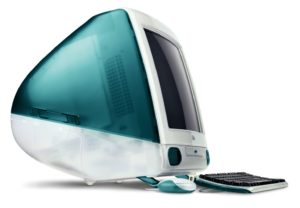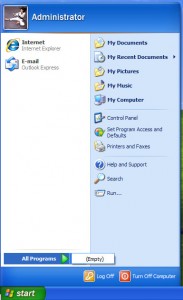
The original iMac, circa 1998.
People often wonder if when to buy a new computer if their old one is still working. If you have a Mac there are some pretty specific guidelines regarding repairs by the manufacturer and even availability of parts.

The original iMac, circa 1998.
People often wonder if when to buy a new computer if their old one is still working. If you have a Mac there are some pretty specific guidelines regarding repairs by the manufacturer and even availability of parts.
 Sometimes after removing a computer virus from a infected Windows PC it looks as though all the user’s documents and programs are GONE. This can cause a panic for the user, not to mention the unseasoned technician. Usually nothing is actually gone, the apparently missing items are just hidden. Here’s a simple fix if this happens to a Windows XP machine:
Sometimes after removing a computer virus from a infected Windows PC it looks as though all the user’s documents and programs are GONE. This can cause a panic for the user, not to mention the unseasoned technician. Usually nothing is actually gone, the apparently missing items are just hidden. Here’s a simple fix if this happens to a Windows XP machine:
1) Go to the Start button (if you can see it). Click My Computer. If you can’t see my computer, push the Windows Flag key (between the CTRL and ALT keys at the lower left of the keyboard) and the letter R at the same time. In the Run box that opens up, type “C:\” (without the quotation marks). Click Okay.
2) Click the Tools menu at the top left of the window. Then click on Folder Options.
3) Click the View tab. Under Files and Folders/Hidden files and folders check the radio button for “Show hidden files and folders”, then click the Okay button at the bottom.
4) Right-click the Documents and Settings folder. Choose (left-click) Properties.
5) If Hidden is checked, uncheck it and click Apply. When the dialogue box comes up check Apply changes to this folder, subfolders and files, then click Okay.
6) During the progress bar for applying the changes if you get an “Error Applying Attributes” message, click Ignore or Ignore All. When the process is finished click Okay.
7) Repeat steps 2 and 3, but this time check the button “Don’t show hidden files or folders” (unless you want the normally hidden files and folders to be visible).
Voila! The “missing” programs, documents, desktop icons, folders and files are back as they were before the virus.
In Windows 7 it’s a bit more complicated. If you have that problem, please contact us for help.

One of the most important things you can do for your peace of mind and security is to back up your computer’s data. Most people don’t care or even think much about backing up, until something goes wrong. At that point everyone cares about restoring what is lost, but of course, if you didn’t back it up you’re pretty much out of luck.
What is your data? Anything stored on your computer – documents, pictures, music, video, projects, etc, are what we call your data. It includes your personal data and your business data. You may also have downloaded programs that you don’t have on a CD or DVD, and cannot download again. Besides backing up your data, it’s a good idea to have a “clone” back up of your whole computer, so if the hard drive fails you can replace everything without having to reinstall from scratch. (That saves a lot of time!).
What could go wrong? All the data on your computer is stored on a fallible piece of hardware called a hard drive. The most common type of hard drive has mirror-finished silver metal platters that spin at speeds up to 7,200 RPM. A metal armature with an electromagnetic tip goes back and forth across the spinning platters reading and writing data in milliseconds. If that hardware gets bumped while it is reading or writing, it can damage either the armature or the platters themselves. Then there is the motor that makes the disks spin and the armature move, and an electronic circuit board called a controller that manages all the activity of the drive. Unfortunately for consumers, any of those parts can fail at any time. Several years ago most hard drives came with a warranty against defects for up to five years. Today most of them come with only a one year warranty. The hard drive manufacturers know the odds that their drives will fail. They figure that one year is a safe bet, but they don’t want to have to cover two years or more. There are some more expensive drives that come with a two, three or even five year warranty, but bear in mind that even if you get a free replacement for the drive, that doesn’t include replacing your lost data. Even the latest solid state drives, which have no moving parts, are still not infallible.
What does backing up mean? Basically it means having your data stored in more than one place. That way if one of the storage media fails, or if you accidentally delete something essential, you can restore it from the other place. The “place” can be a different hard drive, flash drive, or even CD or DVD on site, or it can be at another location. The other location could also be in “the cloud”, which just means on a computer, or server, somewhere on the Internet.
A portable, external hard drive (USB 3.0, 2.0, Firewire or eSata) is an inexpensive, fast option for a local backup. Lately I’ve been using WD Passport Essentials drives, but there are other good options such as Seagate’s GoFlex drives, Hitachi’s G-Drives, and LaCie drives. Try to get one with the longest warranty available. That usually indicates better drive quality.
There are different types of backups. The one major distinction is where to store the backup – “locally”, on a hard drive attached to or wirelessly accessible from your computer, or “in the cloud”, which is a remote backup to a server somewhere on the Internet. Both are important. Local drives allow you to restore large amounts of data much faster than from an online backup, but remote or cloud backups are safer because they are off the premises. No matter what happens to your computer, the off-site backups are there. We recommend doing both.
Backing up should be more or less automatic. If you have to think about backing up too much, and remember to do it regularly, you probably won’t. Most external hard drives of 100 GB or more come with free software for automatic backups. But you still need to install and run the software.
Your Very Own Time Machine. Fortunately for Mac users, Apple has for the past few years included a terrific automatic backup program with the Mac OS X operating system. It’s called Time Machine. As soon as you plug in an external hard drive – whether it has a USB, Firewire or other type of connector, Time Machine recognizes its presence and asks if you want to use that as your Time Machine Backup drive. If you click yes, it will start backing up your computer to it in a couple of minutes. When it has copied your hard drive’s contents, it will do periodic updates to the backup every hour, day, week and month. When the backup drive runs out of space, as eventually it inevitably will, Time Machine will delete the oldest backup to make room for the current state of your computer. It doesn’t delete anything that is still on your computer from the backup, but if you deleted a file or folder, let’s say three months ago, when Time Machine needs more space it will no longer retain that deleted file or folder. The idea is to keep your backup up current, and to keep as many previous versions as you have space for on your backup drive. With Time Machine, you just have to be sure your backup drive is plugged in to your computer whenever you save something new on it, or update an older file. (One caveat: don’t even think about manually deleting the old backups from your Time Machine drive. They are needed to keep the whole backup system intact, since older data is only really backed up again if it changes. Otherwise what look like multiple backups on the drive are really just aliases pointing to the real data).
If you are a Windows PC owner, recent versions of the Windows operating system also have a built-in backup program, but you have to set it up. There are also backup programs that come with just about all of the most popular external hard drive brands, like WD, Seagate and LaCie. Sometimes they have a free version and a premium upgrade option.
Online Backup Services. There are many good online backup services. They all come with their own software, which automates the online backup and updating process. I recommend CrashPlan, Backblaze or Carbonite. They all have PC and Mac versions.
Most of the online backup services, including ibackup.com, will ship the user an empty hard drive with instructions on how to “seed” it with your first backup. If your hard drive has more than 100 GB of data on it, this is the only practical way to start out. If you are not technically inclined, you can hire someone like us to set this up for you. We can start the copying in person or remotely and then you let us know when it’s done and you are ready for the next step. Some services charge a fee for shipping you the seed drive to load up with your data and return. Others include it in the price of a year’s service.
Another great feature of the best online backup services is that if you do have a monumental hard drive failure or other local disaster, they can express ship you a hard drive with all your data on it. That makes recovery much faster than if you had to download everything from the Internet. Prices for this service vary by vendor.
Archiving Data. One more thing about backing up. If your hard drive gets too full, you may want “archive” some data, which means moving it off your computer onto an external hard drive. Just be clear that archiving is NOT the same as backing up. You still need to backup your archive, in case something dire happens to that storage medium. Again, the simple rule of thumb is that if your data isn’t in at least two places, you risk losing it. When it comes to backing up, redundancy is good. Having your data stored in more than two places, with one of the places preferably being off-site, is much better than only two.
Some Backup is Better than None. Whether you just do local backup, online backups, or both, the main thing is to be sure that your data is backed up SOMEWHERE that is safe, reliable, and easy to access. You can even put your most important documents on a flash drive and store it with a friend across town. However you decide to backup, do it often. That major addition to your novel you wrote today won’t be in the backup you did last night.
Trust but Verify. It is very important to TEST your backups from time to time. Don’t assume that everything is working. Pick a file at random and restore it from the backup, just to make sure you can. If you have a mirror backup or “clone” drive, try starting up from it once a month.
Okay, I didn’t back up and now the hard drive doesn’t work. Is there any way to recover my data? Yes, data recovery companies like Drive Savers have industrial grade clean rooms where they can take apart your drive and put the platters on another drive to recover some or all of the data. But that meticulous process comes at a a high price. The minimum charge is usually about $1,000, and it can go much higher, depending on how much data you have to recover, and how much they are able to read from the disk. That makes it a no-brainer: would you rather spend $100 to $200 for a backup drive and software or $1,000 and up for emergency data recovery? Backing up is definitely the better investment, from an emotional as well as a financial perspective.
If you’d like help choosing a backup solution, give us a call. Like insurance, backing up is what you want to think about before disaster strikes, not after.

Two Things to Do Before Hiring Tech Support
It’s amazing how many computer problems can be solved by just a few simple steps. We’d love to have your business, but in all fairness, you can probably save time and money by trying these steps before you hire us or anyone else to fix your computer. We lead our clients through these steps over the phone, and when they solve their problems it seems miraculous to them. Actually, it’s very logical and scientific. NOTE: It might be wise to print this section out for future reference (PDF). If you only have one computer, or you can’t get to the Internet, you might not be able to access this in a crisis.
A. General Computer Problems
1) RESTART (also called REBOOT): It’s amazing how many problems disappear just by restarting the computer. Error messages on the screen like “Not enough memory”, frozen programs or a frozen or endlessly spinning cursor, strange characters in documents, and no Internet connection (wired or wireless) often disappear with a restart. Restarting does not mean just closing the lid on a laptop and then opening it.
To RESTART: In Windows Vista or 7, click the Windows orb button ![]() in the lower left corner of the screen, then click the little right-facing triangle (arrow) next to “Shutdown”, and click on”Restart”.
in the lower left corner of the screen, then click the little right-facing triangle (arrow) next to “Shutdown”, and click on”Restart”.
In Windows XP, click the START button in the lower left corner of the screen, then click “Shutdown”. A window will come up with three buttons, one yellow, one red and one green. Click on the green “Restart” button. Then be patient, as the computer should gradually shutdown and start up again.
2) On a Mac, click the Black Apple icon ![]() in the upper left hand corner of the screen, move the cursor to Restart and release the mouse button. If the Mac orb
in the upper left hand corner of the screen, move the cursor to Restart and release the mouse button. If the Mac orb ![]() has turned into a spinning ball that just keeps on spinning for a couple of minutes, you may have to “Force Quit” an application, or even force the computer to shutdown. To Force Quit, push the keys Command, Option and ESC (Escape) all at the same time. In the “Force Quit Applications” window that comes up on your screen, select the program you were just working in from the list, click on it, and click the blue Force Quit button. Usually that will free the cursor, turning it from a spinning ball back into an arrow.
has turned into a spinning ball that just keeps on spinning for a couple of minutes, you may have to “Force Quit” an application, or even force the computer to shutdown. To Force Quit, push the keys Command, Option and ESC (Escape) all at the same time. In the “Force Quit Applications” window that comes up on your screen, select the program you were just working in from the list, click on it, and click the blue Force Quit button. Usually that will free the cursor, turning it from a spinning ball back into an arrow.
If the Force Quit doesn’t work, try restarting again. If you cannot, find the Power button (the one you push to turn on the computer), push and hold it down until the computer shuts down completely. That will usuall happen in about 20 seconds or less. Wait about 30 seconds for the hard drive to spin to a halt. Then push the power button to restart the computer.
3) On a Windows PC, if the cursor is staying as a spinning circle or hourglass icon, the PC force quit is to hold down the Control (CRTL), Alt and Delete (DEL) keys simultaneously. This brings up the Task Manager window, or a list from which you can choose Task Manager. Under the Applications tab at the left of the window you will see a list of programs. Click on the program you were working in when the cursor got stuck and click the End Task button. If you get a warning saying you will lose unsaved changes, click continue anyway. At this point you have no real option to save your changes because the program has already crashed.
4) If the End Task option in the Windows PC fails to solve the problems, you might be able to restart from the Windows orb button or the START button. If not, hold the power button down until the computer shuts down. Wait about 30 seconds for the hard drive to spin to a halt. Then push the power button to restart the computer. (If you read the Mac instructions above, you can see how similar Windows and Mac computers are these days).
B. Internet Connection Problems
If your web browser tells you it cannot find a web site that you know is there, you may have lost your Internet connection. If your computer is a laptop or you have a wireless connection on your desktop, check the wireless icon and be sure you haven’t inadvertently turned off the wireless adapter.
Losing your Internet connection is often due to a temporary problem with the signal from your Internet Service Provider (ISP) that might require REBOOTING the cable, DSL or Fios MODEM, and the ROUTER (if you have a separate router – you might not). In general here is the step-by-step to restore the Internet connection:
1) Locate the power cord that goes into the back of the modem (that’s the box that was provided by your ISP. It’s usually round and black. Gently pull it out. If there is a latch holding it in place, squeeze the latch in to release it and gently pull the cord out. Set the cord under one of the “feet” of the modem so it won’t slip behind your desk, and so you won’t get the different power cords mixed up. They may have different voltages, so be sure you keep the right cord with the right device.
2) If you have a separate router that connects the computer to the modem, locate and unplug the power cord from the router. Again, it’s usually round and black.
3) Wait about a minute or two.
4) Plug the modem’s power cord back into the modem. The LED lights will go through a reboot sequence. You may see one light blinking, then two, then three, then four, and finally, for a moment, five. Very quickly after they are all flashing in unison, some will go out and others will start blinking. If it’s a DSL modem, you will see one or two lights blinking slowly at first, then rapidly, but in very regular beats. Then at least one of them will start blinking irregularly. That’s when you can proceed to the next step.
5) Plug the router’s power cord back into the router, if you have a router. Wait about a minute until the lights stabilize.
6) Restart your computer. This isn’t always necessary, but it wouldn’t hurt, and might be necessary in some cases.
Note: If you are having to do the steps above frequently, either your modem or router, or both, are probably failing. In that case you should contact your Internet Service Provider for help. If you find it too difficult to deal with your ISP, we can do that on your behalf.
Well, hopefully the steps above have brought you fast relief. If not, give us a call. The number is at the top left of this page.
 I am often asked for help from clients who are trying to decide whether their next computer should be a laptop or a desktop. It’s usually someone who has always had a desktop computer and is thinking of switching to a laptop. Laptops are great. They vary in capabilities from very basic to pretty much as advanced as any desktop. Of course, there are some compromises for the smaller, lighter form factor. Battery life has improved a lot over the past few years, but that’s only relevant when you are using it away from your desk. If you are thinking of switching to a laptop from a desktop, here are some of the pros and cons:
I am often asked for help from clients who are trying to decide whether their next computer should be a laptop or a desktop. It’s usually someone who has always had a desktop computer and is thinking of switching to a laptop. Laptops are great. They vary in capabilities from very basic to pretty much as advanced as any desktop. Of course, there are some compromises for the smaller, lighter form factor. Battery life has improved a lot over the past few years, but that’s only relevant when you are using it away from your desk. If you are thinking of switching to a laptop from a desktop, here are some of the pros and cons:
Laptop Pros
Lightweight, compact footprint, lower power usage, portability, easy to take to a store for service. Easy to fit in any room, or take from room to room.
Laptop Cons
While you are at it, look at the new Macs. They are gorgeous, and you can run both Mac and Windows 7 on them easily, using the program Parallels 7. I am writing this from within Outlook 2007 for Windows, inside the Windows 7 environment, on a Mac Pro desktop computer.
Your biggest choices are between a big screen that’s easy on the eyes but heavier, or a smaller screen that’s in a lighter laptop. The best thing is to go to a store that sells Dell (like Best Buy) and hold different models in your hands, see what the screen looks like to your eyes, and type on the keyboard. Also check out the Macs at any Apple Store.